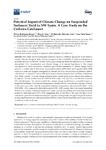Mostrar o rexistro simple do ítem
Potential Impact of Climate Change on Suspended Sediment Yield in NW Spain: A Case Study on the Corbeira Catchment
| dc.contributor.author | Rodríguez-Blanco, María-Luz | |
| dc.contributor.author | Arias, Ricardo | |
| dc.contributor.author | Taboada-Castro, María Mercedes | |
| dc.contributor.author | Nunes, Joao Pedro | |
| dc.contributor.author | Keizer, Jan Jacob | |
| dc.contributor.author | Taboada-Castro, M.T. | |
| dc.date | 2016 | |
| dc.date.accessioned | 2017-09-26T10:56:41Z | |
| dc.date.available | 2017-09-26T10:56:41Z | |
| dc.date.issued | 2016 | |
| dc.identifier.citation | Rodríguez-Blanco, M.L.; Arias, R.; Taboada-Castro, M.M.; Nunes, J.P.; Keizer, J.J.; Taboada-Castro, M.T. Potential Impact of Climate Change on Suspended Sediment Yield in NW Spain: A Case Study on the Corbeira Catchment. Water 2016, 8, 444. | es_ES |
| dc.identifier.issn | 2073-4441 | |
| dc.identifier.uri | http://hdl.handle.net/2183/19535 | |
| dc.description.abstract | [Abstract] Soil losses and the subsequent sediment delivery constitute significant environmental threats. Climate change is likely to have an impact on the availability of water and therefore on sediment yield in catchments. In this context, quantifying the sediment response to an increased atmospheric CO2 concentration and climate change is of utmost importance to the proper management of rural catchments. However, quantitative assessment of climate change impact remains a complex task. In this study, the potential medium (2031–2060) and long-term (2069–2098) impacts of projected changes of temperature, rainfall and CO2 concentration on sediment yield in a small rural catchment located in NW Spain were evaluated using the Soil and Water Assessment Tool (SWAT) model. Climate change scenarios were created using future climate data projected by regional climate models from the ENSEMBLES project and two CO2 concentration scenarios (550 and 660 ppm). The results showed that climate change would have a noticeable impact on suspended sediment if the forecast temperature, rainfall and CO2 concentration changes included in this study were met. Overall, suspended sediment is expected to decrease (2031–2060: −11%, 2069–2098: −8%) compared to the baseline period (1981–2010), mainly due to decreased streamflow. However, an increase in sediment transport in winter is predicted, possibly associated with increased erosion in cultivated areas (11%–17%), suggesting that, at this time of the year, the effect of soil detachment prevails over sediment transport capacity. Consequently, management practices aimed at reducing soil erosion in cultivated areas should be carried out, because these are the main source of sediment in the study area. | es_ES |
| dc.description.sponsorship | Galicia. Consellería de Economía e Industria; 10MDS103031 | es_ES |
| dc.description.sponsorship | Ministerio de Economía y Competitividad; CGL2014-56907-R | es_ES |
| dc.language.iso | eng | es_ES |
| dc.publisher | Multidisciplinary Digital Publishing Institute | es_ES |
| dc.relation.uri | http://dx.doi.org/10.3390/w8100444 | es_ES |
| dc.rights | Reconocimiento 3.0 | es_ES |
| dc.rights.uri | http://creativecommons.org/licenses/by/3.0/ | |
| dc.subject | Rural catchment | es_ES |
| dc.subject | Suspended sediment | es_ES |
| dc.subject | SWAT model | es_ES |
| dc.subject | Climate change | es_ES |
| dc.title | Potential Impact of Climate Change on Suspended Sediment Yield in NW Spain: A Case Study on the Corbeira Catchment | es_ES |
| dc.type | info:eu-repo/semantics/article | es_ES |
| dc.rights.access | info:eu-repo/semantics/openAccess | es_ES |
| UDC.journalTitle | Water | es_ES |
| UDC.volume | 8 | es_ES |
| UDC.issue | 10 | es_ES |
| UDC.startPage | 444 | es_ES |
Ficheiros no ítem
Este ítem aparece na(s) seguinte(s) colección(s)
-
GI-GRICA - Artigos [49]






